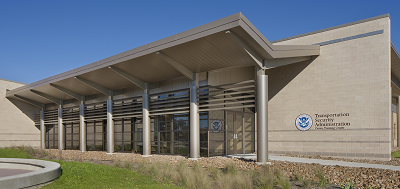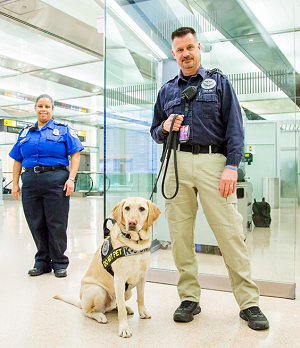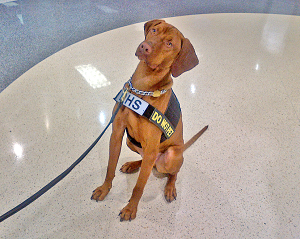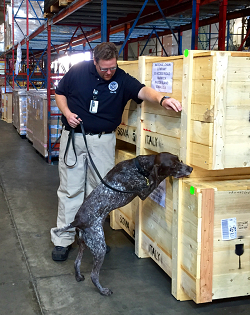Overview

The TSA National Explosives Detection Canine Program trains and deploys both TSA-led and state and local law enforcement-led canine teams in support of day-to-day activities that protect the transportation domain. These highly trained explosives detection canine teams are a reliable resource at detecting explosives and provide a visible deterrent to terrorism directed towards transportation systems.
TSA trains canine teams to operate in the aviation, multimodal, maritime, mass transit, and cargo environments. Considered the "center for excellence" for explosives detection canine training, the program is the largest explosives detection canine program in the Department of Homeland Security and the second largest in the federal government after the Department of Defense.
Canine Training Teams
-
Canine teams may consist of transportation security inspectors or local or state law enforcement officers who are paired with explosives detection canines and work in airports, maritime, mass transit and cargo facilities across the nation.

- Law enforcement officers make up approximately 60 percent of the teams and approximately 40 percent are transportation security inspectors.
- TSA provides and trains the dog, trains the handler, provides training aides and explosives storage magazines, and conducts annual on-site canine team certifications.
- TSA partially reimburses each participating agency for operational costs associated with maintaining the teams, including veterinary fees, handler salaries, dog food, and equipment.
- In return, the law enforcement agencies agree to use the canines in their assigned transportation environment for at least 80 percent of the handler’s duty time.
Canine Training Course
- TSA’s explosives detection canines are trained on a variety of explosives based on intelligence data and emerging threats.
- Conventional explosives detection canine handlers undergo a 11-week training course. Passenger screening canine handlers undergo a 16-week training course.
- Canine teams graduate from the TSA canine course after demonstrating proficiency in various venues inclusive of all transportation environments including airport, terminal, freight, cargo, baggage, vehicle, bus, ferry and rail.
- Once a team graduates from the training program, they return to their duty station to acclimate and familiarize the canine to their assigned operational environment.
- Each team is continually assessed to ensure the canines demonstrate operational proficiency in their environment to include four key elements: the canine’s ability to recognize explosives odors, the handler’s ability to interpret the canine’s change of behavior, the handler’s ability to conduct logical and systematic searches, and the team’s ability to locate the explosives odor source.
Training Facilities
- Located at Joint Base San Antonio-Lackland in San Antonio, Texas, the $12 million Canine Training Center includes 25,000 square feet of space with seven classrooms, office space that accommodates 140 employees, and a 100-seat auditorium.
- There are 17 indoor venues on the premises that mimic a variety of transportation sites and modes. This includes a cargo facility, an airport gate area, a checkpoint, a baggage claim area, the interior of an aircraft, a vehicle parking lot, a light rail station, a light rail car, an air cargo facility, two mock terminals, and open area searches venues for air scenting.
- Kennels that can accommodate approximately 350 dogs.
- The canine training center also utilizes a variety of training venues in and around the San Antonio area including San Antonio International Airport, local shopping malls, the ATT Center, and the VIA Bus Terminal.
Canines by the Numbers
-
325: average number of canines that complete training per year

- 160: average number of canines in training at any given time
- 7: breeds of canines that are in the program, to include German Shepherds, Labrador Retrievers, German Short-haired Pointers, Wirehaired Pointers, Vizslas, Belgian Malinois, Golden Retrievers
- $33,000: average cost to train a canine a traditional explosives detection canine and handler and $46,000 for a passenger screening canine and handler
- Approximately 83 percent of canines graduate from the training program
Canine Capabilities
-
There are more than 1,000 TSA canine teams deployed nationwide that are tasked with screening passengers and cargo, and supporting other security missions.

- In 2019, there were more than 300,000 canine utilization hours throughout the nation’s transportation system.
- Canine teams work at more than 100 of the nation’s airports, mass-transit and maritime systems.
- Canine teams are a highly mobile and extremely efficient explosives detection tool to deter, detect and respond to threats throughout the nation’s transportation environments.
Last Updated on May 19, 2021
